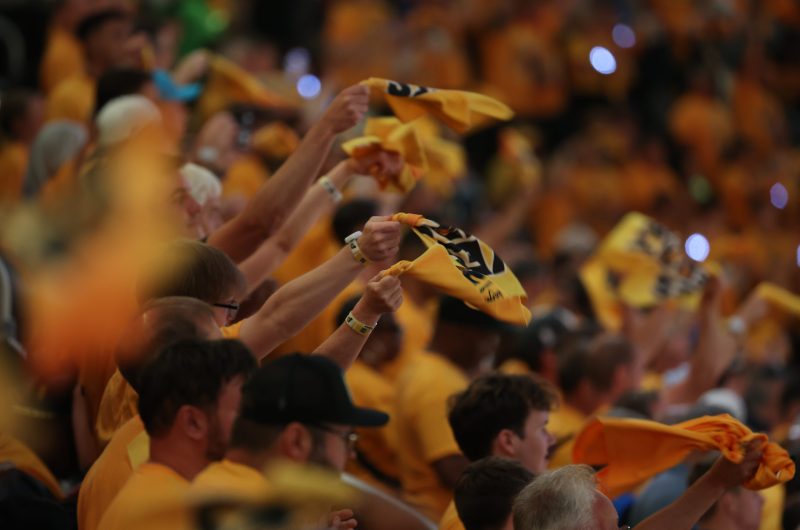INDIANAPOLIS — The NBA Finals TV ratings discussion is a classic struggle between the optimist and the pessimist.
One headline: ‘NBA Finals have been most-watched programs since first week of May.”
Another headline: “NBA Finals ratings down 24%.”
Two things can be true in this season’s Finals between “small-market” Indiana and Oklahoma City.
Yes, ratings are down from last season’s Finals between Boston and Dallas, and yes, the Thunder-Pacers Finals have brought in millions of viewers, including a peak of 11.54 million at 11 p.m. ET of Game 3 on Wednesday, June 11.
Of the top 10 TV shows June 2-8, four were NBA-related for ABC: Games 1 and 2 of the Finals, postgame coverage of Game 2, and the Game 1 pregame show. Those four totaled 25.6 million viewers, including 8.9 million for Game 1 and 8.7 million for Game 2, according to Nielsen.
The topic of NBA TV ratings is shaped by the teams playing; the lack of household names driving the competition even though OKC’s Shai Gilgeous-Alexander is this season’s MVP and Tyrese Haliburton is a two-time All-Star, 2024 Paris Olympics gold medalist and cold-blooded, game-winning shooter; a new era in which different teams are playing the Finals each season; and stars not named LeBron James, Steph Curry and Kevin Durant getting to the Finals.
The league and its TV partners need to navigate those issues, and they are focused on attracting more viewers, especially casual sports fans.
But, if you were to ask the league and Disney/ABC/ESPN if they are unhappy with the numbers, their answer is no. Would they like more viewers? Of course.
However, winning the night and winning with key demographics is exactly what they and corporate/partners advertisers want.
In today’s world of viewing consumption – streaming, multiple devices, YouTube highlights – nuance is required. Nielsen numbers are important but no longer the only factor.
“Ratings have changed from what they used to be,” NBA Commissioner Adam Silver said before Game 1 of the Finals. “Netflix is the most valuable pure play media company out there. Nobody in this room knows what their ratings are. We don’t even think in terms of ratings. We think maybe in terms of popularity, buzz around a program. We’re going through a transition, and we’re going to work through that.”
Silver and his business operations staff have given considerable thought to the topic. Don’t fret too much for the league. The NBA’s nine-year, $24 billion TV deal expires after the Finals, and the new 11-year, $76 billion pact with ESPN/ABC, NBC and Amazon starts next season.
That’s almost triple the previous deal. Before that deal was secured, there was skepticism that the NBA could net a deal that averaged $7 billion annually. But Silver got it done. That amount does not include the league’s media deals with international broadcast partners.
For the TV partners, the amount they agreed to pay the NBA was not arbitrarily snagged from the ether. High-paid executives analyzed the data and the financials and settled on a figure that allows their network to make money.
There is extreme value in the NBA, and that’s also reflected in the value of franchises. The Boston Celtics are expected to sell for at least a valuation of $6.1 billion, and if the NBA decides to expand, those expansion teams will go for at least $6 billion.
Live sports on TV remain desirable to traditional and modern means of consumption. The NBA’s YouTube channel has more than 20 million followers, its X account has 48 million followers, its Instagram account has 90.8 million followers and its Facebook account has 50 million followers.
In February, Disney CEO and chairman Bob Iger said, “We obviously believe in the NBA long term. We think it’s a growth sport. We don’t really look at ratings year-to-year that carefully. … We’re not distracted in any sense by what’s happening ratings-wise this season. We’re happy to have this now for 11 more years, including the Finals in 10 of those years. It is and will continue to be a marquee part of ESPN’s offering.”
Also in February, this time at All-Star Weekend in San Francisco, Silver addressed the topic with a five-minute answer when asked by USA TODAY Sports how the NBA views TV ratings and what is considered success. It’s clearly a topic that is front of mind for Silver.
“I like the challenge, frankly, because I think for the league, and together with our partners, we have to up our game at the same time,” Silver said. “There’s a lot more competition for attention than there used to be. Just think of all of your habits in the room for people who grew up watching more traditional television. …
“I don’t think that kind of engagement through social media is necessarily a substitute for watching live games because that comes up all the time. Some suggesting, ‘Well, isn’t that bad you’re training the next generation of fans who might never watch live games but only watching highlights?’ I actually think it’s additive. We have a much better chance of moving young fans, in particular, to live games if they become engaged with various forms of our content, whether it’s things that our players are doing off the floor, music they love, fashion or highlights.”
TV ratings for the NBA’s 2024-25 season were down 2% which mirrors the NFL’s 2.2% decline for its 2024 season. Through the NBA’s conference finals, playoff ratings were up 3%, and viewership for Games 1 and 2 was 50% higher than the next three highest-rated shows (“The Tony Awards,” “60 Minutes,” “America’s Got Talent”) for the week of June 2-8.
Thunder-Pacers has turned into a compelling series of talented, well-coached teams whose offensive and defensive efforts make every possession matter.
This Finals is going at least six games, and any Finals series that goes more than five games is a financial success for the league’s TV partners.

